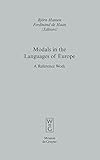Modals in the Languages of Europe : A Reference Work / ed. by Björn Hansen, Ferdinand de Haan.
Material type: TextSeries: Empirical Approaches to Language Typology [EALT] ; 44Publisher: Berlin ; Boston : De Gruyter Mouton, [2009]Copyright date: ©2009Description: 1 online resource (577 p.) : Figs., tabs. and mapsContent type:
TextSeries: Empirical Approaches to Language Typology [EALT] ; 44Publisher: Berlin ; Boston : De Gruyter Mouton, [2009]Copyright date: ©2009Description: 1 online resource (577 p.) : Figs., tabs. and mapsContent type: - 9783110219203
- 9783110219210
- 415.6 22/ger
- P299.M6 M65 2009eb
- online - DeGruyter
- Issued also in print.
| Item type | Current library | Call number | URL | Status | Notes | Barcode | |
|---|---|---|---|---|---|---|---|
 eBook
eBook
|
Biblioteca "Angelicum" Pont. Univ. S.Tommaso d'Aquino Nuvola online | online - DeGruyter (Browse shelf(Opens below)) | Online access | Not for loan (Accesso limitato) | Accesso per gli utenti autorizzati / Access for authorized users | (dgr)9783110219210 |
Frontmatter -- Contents -- List of contributors -- Abbreviations used in glossing -- 1. Introduction -- A. Modals in Indo-European languages (Western branch) -- 2. Modals in the Germanic languages -- 3. Modals in Irish -- 4. Modals in the Romance languages -- 5. Modals in Greek -- B. Modals in Indo-European languages (Eastern branch) -- 6. Modals in the Slavonic languages -- 7. Modals in Baltic -- 8. Modals in Albanian -- 9. Modality in Romani -- C. Modals in Non-Indo-European languages -- 10. The grammaticalisation of modal auxiliaries in Maltese and Arabic vernaculars of the Mediterranean area -- 11. Modal verbs in Balto-Finnic -- 12. Modals in Hungarian -- 13. Mood and modality in Berber -- 14. Modality in Basque -- 15. Modals in Turkic -- 16. Concluding chapter: modal constructions in the languages of Europe -- Backmatter
restricted access online access with authorization star
http://purl.org/coar/access_right/c_16ec
This book is the first comprehensive survey of modals and modal constructions in the languages of Europe. It is a collaborative effort between scholars from Europe and the United States, stemming from a workshop on Modals in the Languages of Europe in Valencia. The aim of this book is to describe the properties of modals and modal constructions in the European area and to compare the systems in individual languages or language families from an areal and genetic perspective. For the sake of contrast, the book also looks at the expression of modality in some languages just outside of Europe. The book consists of fourteen chapters on modal systems in individual languages or language families, written by experts in the respective languages, and an introductory and concluding chapter, written by the editors. The book gives both a description of the modals in the individual languages and an account of the nature and status of modals in general. It provides the reader with a theoretical account of how modals and modal constructions are grammaticalized. This theoretical account is informed by the parameters of grammaticalization of Christian Lehmann. These parameters were chosen because they are language-independent, as opposed to more language specific criteria (for instance, the NICE-criteria for English). The parameters themselves are examined as well for their suitability as part of any theory of grammaticalization. The book thus gives readers access to a collection of data on modality that surpasses most works in this field and also provides a fresh perspective on issues of grammaticalization and language contact. It is therefore of interest to scholars of modality, language contact and areal linguistics, grammaticalization theory and typology.
Issued also in print.
Mode of access: Internet via World Wide Web.
In English.
Description based on online resource; title from PDF title page (publisher's Web site, viewed 28. Feb 2023)


